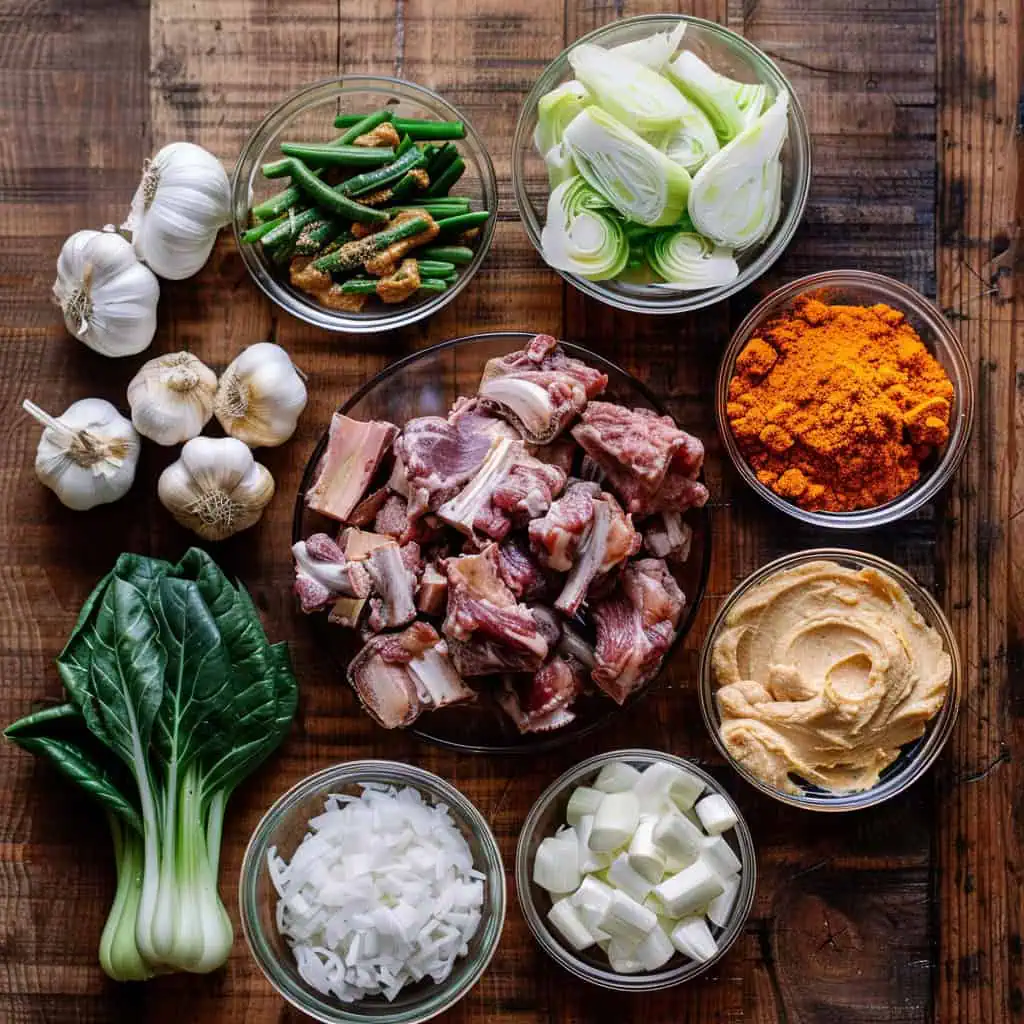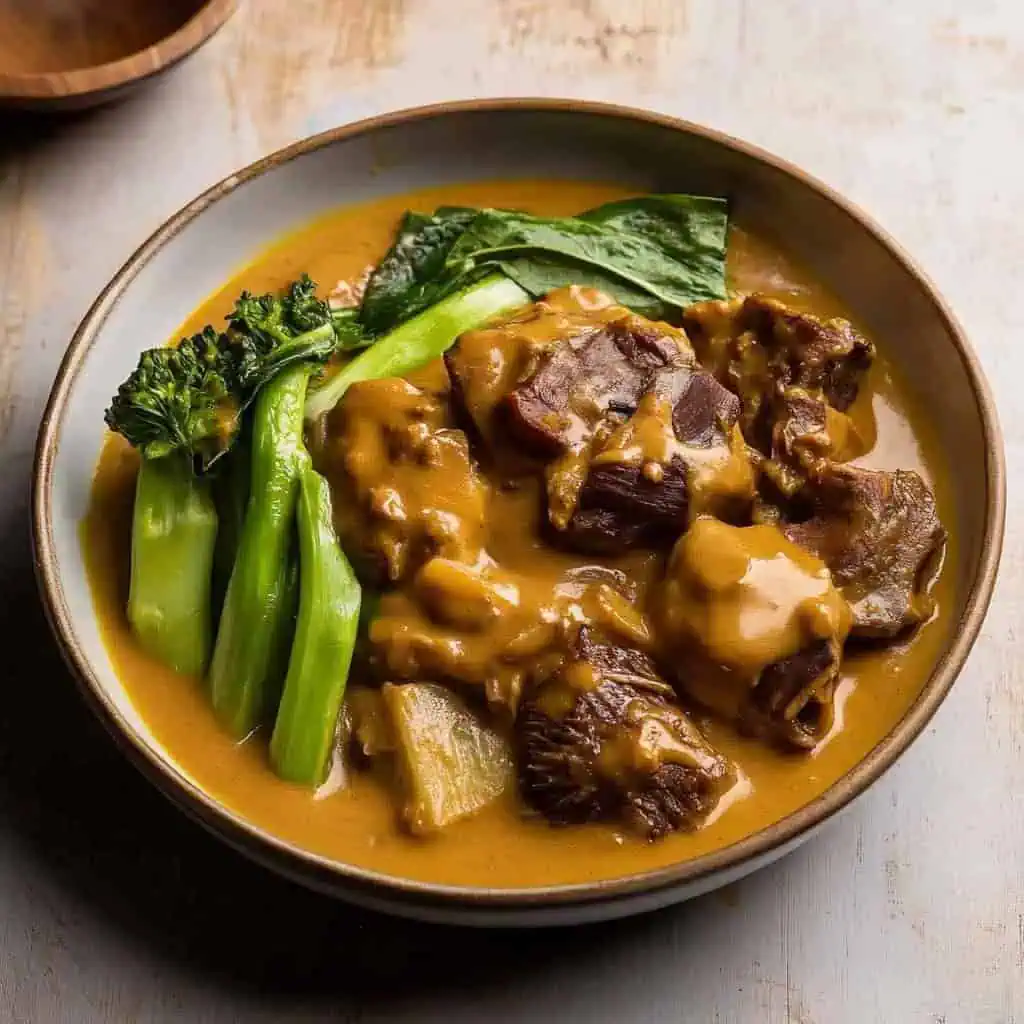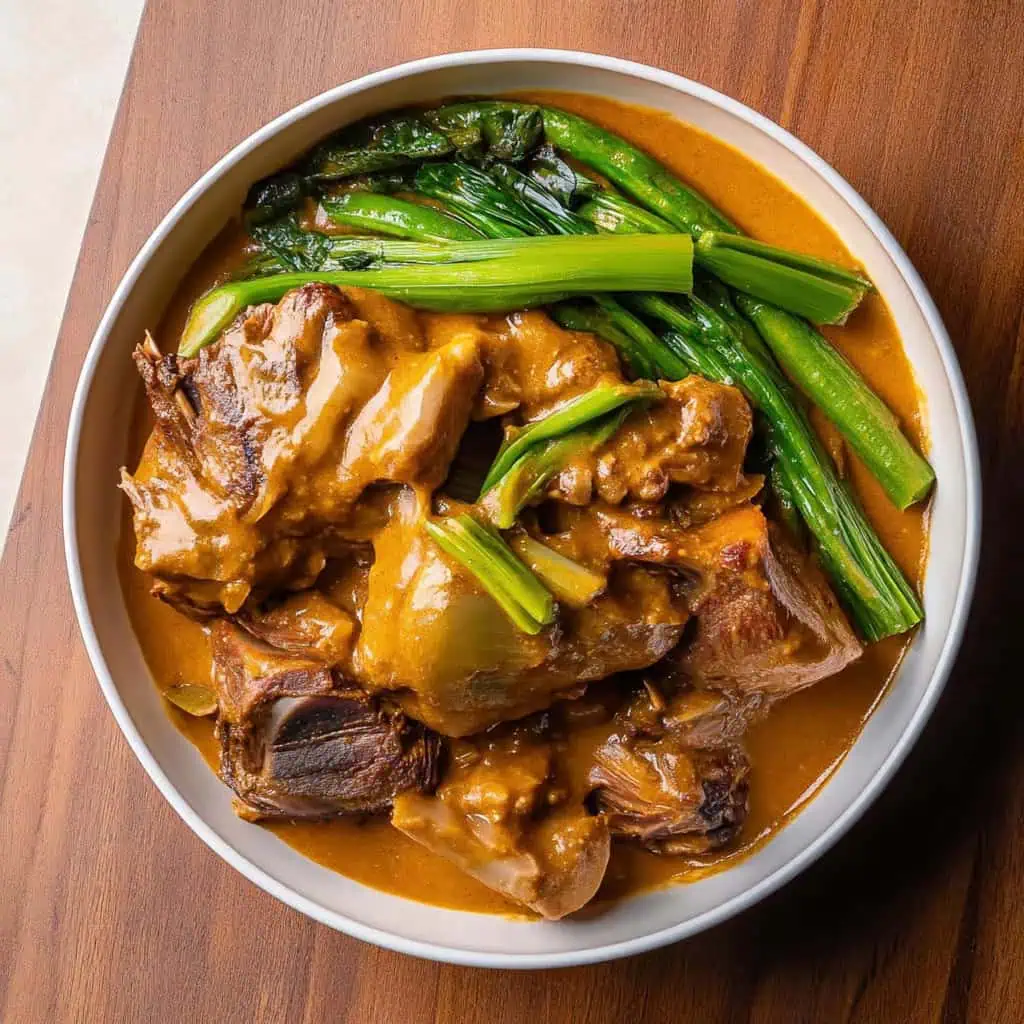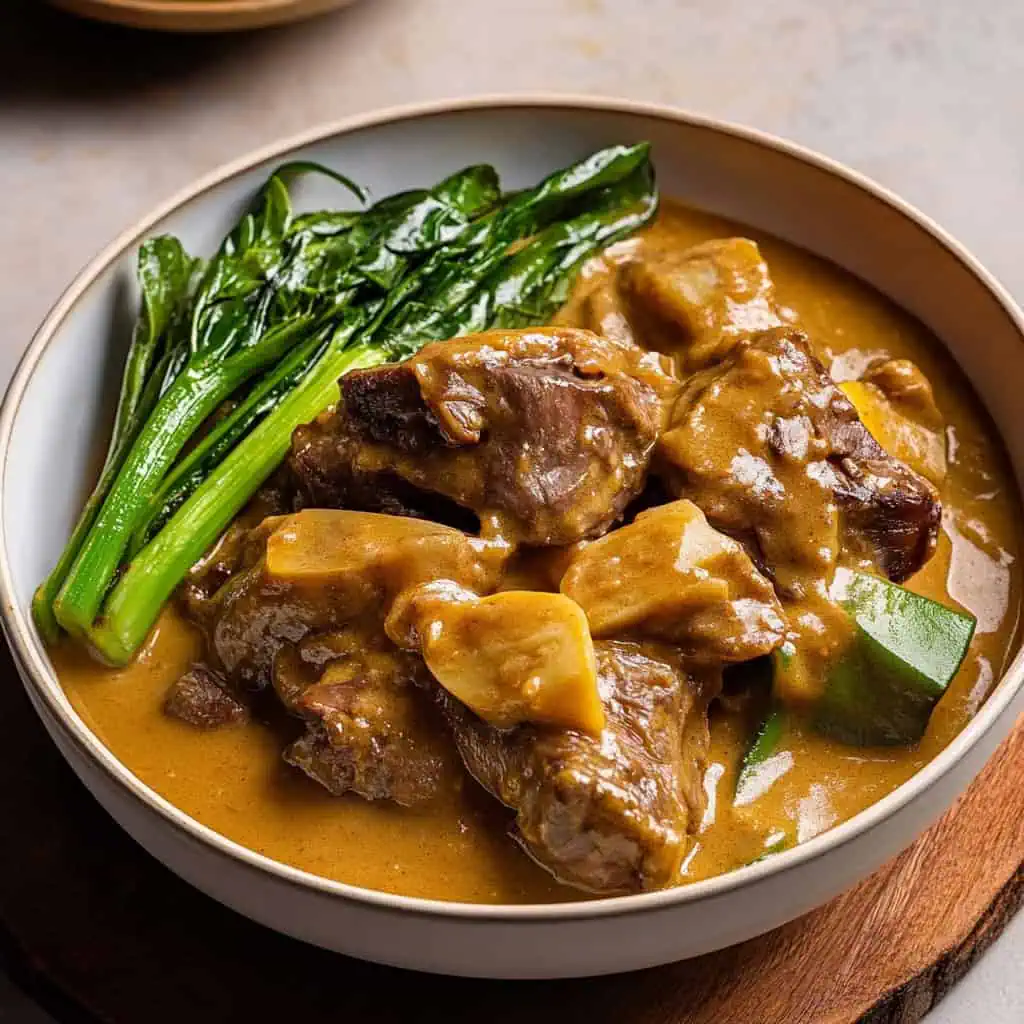This authentic Filipino Kare-Kare recipe transforms buttery-soft oxtail and fresh vegetables into an unforgettable feast, featuring a rich, velvety peanut sauce that's become a cornerstone of Filipino celebration cooking.
I learned the secrets of this treasured dish from my best friend, Valerie, whose Kapampangan family has perfected it through generations. The key lies in the patient preparation, slowly tenderizing the oxtail until it falls off the bone, carefully toasting the rice flour until golden, and achieving that perfect sauce consistency that's become increasingly rare even in restaurants today.
While this homemade recipe requires time and attention, the result is a restaurant-quality Kare-Kare that brings together the authentic flavors of ground peanuts, annatto, and tender meat in a way that makes every gathering truly special.
Jump to:

Why You'll Love This Recipe
- Restaurant Quality: Achieve the same rich, velvety sauce you'd find in high-end Filipino restaurants
- Complete Guide: Step-by-step instructions with pro tips from generations of Filipino cooks
- Make-Ahead Friendly: Perfect for special occasions with prep-ahead options
- Authentic Taste: Traditional Kapampangan recipe passed down through generations
- Customizable: Various options for meat cuts and vegetables to suit your preferences
Ingredients
Each component of Kare-Kare serves a specific purpose in creating this iconic dish. Oxtail provides rich gelatin that gives the sauce its luxurious mouthfeel, while the combination of toasted rice flour and peanut butter creates the signature thick, velvety texture.
Annatto adds the distinctive golden-orange color without affecting flavor. The contrasting vegetables offer textural variety and visual appeal, from the creamy eggplant to the crisp string beans.
The essential finishing touch comes from bagoong alamang (fermented shrimp paste), which cuts through the richness with its salty, umami punch – creating the perfect balance that makes Kare-Kare truly special.

For the Meat Base:
- 3 lbs oxtail (buntot ng baka), cut into 2-inch pieces
- 1 lb honeycomb tripe (tuwalya), optional
- 8-10 cups water
- 2 tablespoons cooking oil (any neutral oil)
- 3 star anise
- 4 bay leaves
For the Peanut Sauce:
- 1 cup unsweetened peanut butter
- ¼ cup rice flour, toasted
- 2 tablespoons annatto powder (or 3 tablespoons annatto seeds)
- 1 large onion, finely diced
- 6 cloves garlic, minced
- 1 thumb-sized piece ginger, minced
Vegetables:
- 2 Japanese eggplants, cut diagonally into 2-inch pieces
- 2 bundles string beans, cut into 3-inch lengths
- 1 banana heart, quartered and sliced
- 2 bunches bok choy
- 1 cup calabaza squash (optional), cut into 2-inch pieces
Seasonings:
- Fish sauce (patis) to taste
- Sea salt to taste
- Freshly ground black pepper to taste
- Shrimp paste (bagoong alamang) for serving
- Calamansi or lime wedges for serving
- Steamed jasmine rice for serving
Equipment
- 8-10 Quart Heavy-Bottom Pot: For properly cooking the meat until tender (preferably a Dutch oven)
- Cast Iron Skillet: For toasting the rice flour to develop proper flavor
- Fine Mesh Strainer: To achieve a smooth, restaurant-quality sauce
- Large Sauté Pan: For developing the peanut sauce base
- Blanching Pot: For properly cooking vegetables to perfect texture
- Sharp Chef's Knife: For precise cutting of meat and vegetables
- Deep Serving Bowl: Traditional presentation requires a wide, deep serving dish
- Wooden Spoon: For gentle stirring without breaking the delicate vegetables

How To Make
Day Before Preparation (For Best Results)
- Prep the Oxtail: Thoroughly clean the oxtail under cold running water. Parboil for 5 minutes in boiling water, drain, and rinse again to remove impurities. This creates a cleaner-tasting broth.
- Refrigerate Overnight: Place cleaned oxtail in a container and refrigerate overnight. This makes it easier to remove excess fat and deepens flavor development.
Cooking Day
Step 1: Tenderize the Meat (2-2.5 hours)
- Remove the oxtail from the refrigerator 30 minutes before cooking to bring to room temperature.
- In a large, heavy-bottom pot, place the oxtail and cover with cold water. Add star anise and bay leaves.
- Bring to a boil over high heat, then reduce to medium-low.
- Skim off any scum that rises to the surface for a clearer broth.
- Cover and simmer for 2-2.5 hours, checking occasionally and adding more water if needed. The meat should be very tender and almost falling off the bone.
Step 2: Create the Peanut Sauce Foundation (15 minutes)
- In a dry cast iron pan over medium heat, toast the rice flour until golden brown and fragrant, stirring constantly (5-7 minutes). Set aside.
- Heat cooking oil in a large pan over medium heat.
- Sauté minced garlic until light golden (about 1 minute).
- Add ginger and sauté for another minute.
- Add diced onions and cook until translucent (3-4 minutes).
Step 3: Develop the Signature Sauce (20 minutes)
- Add the peanut butter and annatto powder to the sautéed aromatics.
- Gradually add 2 cups of the hot broth from the cooking meat, stirring constantly to prevent lumps.
- Simmer for 10 minutes, stirring occasionally.
- Add the toasted rice flour to the peanut mixture, stirring constantly to prevent lumps.
- Add more broth as needed to achieve desired consistency. The sauce should be thick but still pourable, coating the back of a spoon.
Step 4: Prepare the Vegetables (15 minutes)
- Soak the banana heart in salted water for 15 minutes to remove bitterness.
- Bring a pot of water to boil for blanching vegetables.
- Blanch each vegetable separately:
- String beans: 3-4 minutes
- Eggplant: 2-3 minutes
- Banana heart: 4-5 minutes
- Calabaza squash (if using): 3-4 minutes
- Bok choy: 1-2 minutes
- Drain each vegetable and set aside.
Step 5: Final Assembly (10 minutes)
- Once meat is tender, remove it from the broth and set aside.
- Strain the remaining broth and add it to the peanut sauce until you achieve your desired consistency.
- Return the meat to the sauce and simmer for 5 minutes.
- Season with fish sauce and freshly ground black pepper to taste.
- Let the dish rest for 15-20 minutes before serving to allow flavors to meld.
Step 6: Traditional Presentation
- Arrange the meat in the center of a large, deep serving bowl.
- Pour the peanut sauce over the meat.
- Arrange the blanched vegetables around the meat in a decorative pattern.
- Serve hot with:
- Steamed jasmine rice
- Shrimp paste (bagoong alamang) in a separate dish
- Calamansi or lime wedges

Tips from Lola's Kitchen
- Two-Day Process: For restaurant-quality results, always clean and parboil the oxtail the day before cooking.
- Bone Broth Quality: Never rush the meat simmering process, the collagen from the bones creates the signature silky mouthfeel.
- Sauce Technique: Add broth to the peanut mixture gradually while whisking continuously to prevent lumps and separation.
- Rice Flour Toasting: Don't skip toasting the rice flour until golden brown. This develops the nutty flavor foundation.
- Vegetable Timing: Blanch vegetables separately and add them only at serving time to maintain their vibrant colors and textures.
- Resting Period: Allow the finished dish to rest 15-20 minutes before serving to let flavors develop and sauce thicken slightly.
- Bagoong Balance: The perfect bite includes a small amount of fermented shrimp paste, it's meant to complement, not overpower.
- Color Check: Authentic Kare-Kare should have a golden amber color, not too yellow or too brown.
- Consistency Test: The perfect sauce should coat the back of a spoon but still flow slowly when tilted.
- Leftovers Secret: Kare-Kare often tastes even better the next day after flavors have fully melded.
Substitutions
Meat Options
- Instead of Oxtail: Beef shank (bulalo), beef chuck, or short ribs work well
- Instead of Tripe: You can omit entirely or use beef tongue for a different texture
- Vegetarian Option: Substitute firm tofu, mushrooms (particularly king oyster or shiitake), and add extra vegetables
Sauce Alternatives
- Fresh Peanuts: For an even more authentic version, use 2 cups roasted peanuts ground into a paste
- Rice Flour Substitute: 3 tablespoons cornstarch or all-purpose flour (though the flavor profile will be slightly different)
- Annatto Alternative: 1 tablespoon paprika mixed with ½ teaspoon turmeric for color
Vegetable Substitutions
- Banana Heart: Substitute with cabbage, more eggplant, or green papaya
- Japanese Eggplant: Regular eggplant cut into chunks works well
- Bok Choy: Any leafy greens like spinach, mustard greens, or Napa cabbage
- String Beans: Green beans, snow peas, or even asparagus can work
- Calabaza Squash: Kabocha, butternut, or any sweet winter squash
Troubleshooting
Sauce Issues
- Grainy Sauce: Lower heat when adding peanut butter and whisk continuously. For fixing, blend sauce in a blender and strain.
- Too Thick: Add hot broth or water gradually, 2 tablespoons at a time, while stirring gently.
- Too Thin: Continue simmering uncovered to reduce, or add 1 teaspoon of toasted rice flour mixed with 2 tablespoons of sauce, then stir in.
- Sauce Separating: Sauce was likely overheated. Lower heat and whisk gently to recombine.
- Not Enough Flavor: Ensure you're using unsweetened natural peanut butter, and don't skip the toasting of rice flour.
Meat Problems
- Tough Meat: Continue simmering in 30-minute increments until tender. Patience is key!
- Falling Apart Too Much: You've overcooked slightly. Still delicious, but next time reduce cooking by 20-30 minutes.
- Not Enough Meat Flavor: Make sure to properly parboil and clean the meat, but don't rinse away all the flavor after parboiling.
Vegetable Concerns
- Bitter Banana Heart: Soak longer in salted water (up to 30 minutes) and ensure you're removing all fibrous parts.
- Mushy Vegetables: You've overcooked them. Blanch for less time or refresh in ice water immediately after blanching.
- Vegetables Not Cooked Enough: Return to simmering sauce for 1-2 minutes to finish cooking.
Storage & Reheating
Refrigerator Storage
- Store meat and sauce together in an airtight container for up to 4 days.
- Store blanched vegetables separately for up to 2 days.
- The flavor actually improves after 24 hours as the flavors meld.
Freezer Storage
- Freeze meat in sauce for up to 3 months in freezer-safe containers.
- Note that the sauce may separate when thawed, but can be recombined.
- Do not freeze the blanched vegetables as they will become mushy.
Proper Reheating
- Thaw frozen Kare-Kare overnight in the refrigerator.
- Reheat in a pot over low heat, stirring gently and frequently.
- Add 2-4 tablespoons of fresh broth or water if needed to restore consistency.
- Heat only until just warmed through to prevent sauce from breaking.
- Prepare fresh vegetables for best quality if reheating frozen Kare-Kare.

FAQ
How long does authentic Kare-Kare take to make?
About 3-3.5 hours active cooking time, plus overnight preparation for best results.
Can I use a pressure cooker or Instant Pot?
Yes! Cook oxtail for 45 minutes on HIGH pressure with natural release for similar tenderness.
Is there a quick version for weeknights?
Use beef stew meat cut into chunks and cook for 1 hour, or try the chicken variation.
How do I know when the meat is done?
It should easily separate from the bone and feel tender when pierced with a fork.
Why is bagoong alamang (shrimp paste) essential?
It provides the necessary salt and umami that balances the richness of the peanut sauce.
Can I make this nut-free?
Substitute with sunflower seed butter, though the flavor will be different.
Is there a shortcut for the annatto?
Use annatto oil from Asian markets or the annatto powder mentioned in alternatives.
Why add vegetables last?
To prevent overcooking and maintain their vibrant colors and textures.
When is Kare-Kare typically served in Filipino culture?
It's traditionally served at special occasions like fiestas, Christmas gatherings, and important family celebrations.
What does the name Kare-Kare mean?
The name likely comes from "kari" (meaning sauce) or may be related to the word "curry," pointing to possible Indian influences.
Why is this dish considered special in Filipino cuisine?
Its complex preparation and rich ingredients made it historically a dish for special occasions, and it represents the Filipino talent for culinary adaptation.
Related
Looking for other recipes like this? Try these:

Filipino Kare-Kare (Traditional Oxtail and Peanut Stew)
Ingredients
For the Meat Base:
- 3 lbs oxtail buntot ng baka, cut into 2-inch pieces
- 1 lb honeycomb tripe tuwalya, optional
- 8-10 cups water tubig
- 2 tablespoons cooking oil mantika
For the Peanut Sauce:
- 1 cup unsweetened peanut butter mantikang mani
- ¼ cup rice flour galapong, toasted
- 2 tablespoons annatto powder atsuete or 3 tablespoons annatto seeds
- 1 large onion sibuyas, diced
- 6 cloves garlic bawang, minced
Vegetables (Gulay):
- 2 Japanese eggplants talong, cut diagonally
- 2 bundles string beans sitaw, cut into 3-inch lengths
- 1 banana heart puso ng saging, quartered and sliced
- 2 bunches bok choy pechay
Seasonings:
- Fish sauce patis to taste
- Sea salt asin to taste
- Ground black pepper paminta to taste
- Shrimp paste bagoong alamang for serving
Instructions
- The day before cooking (Isang araw bago magluto), thoroughly clean the oxtail under cold running water (Hugasang mabuti ang buntot ng baka sa malamig na tubig). Parboil the oxtail for 5 minutes in boiling water, drain, and rinse again to remove impurities (Pakuluan ang buntot ng baka ng 5 minuto, alisin ang tubig, at banlawan muli). Place in a container and refrigerate overnight. This step makes it easier to remove excess fat and results in a cleaner-tasting broth.
- On cooking day, remove the oxtail from the refrigerator 30 minutes before cooking to bring it to room temperature (Ilabas ang karne sa ref 30 minuto bago magluto). In a large, heavy-bottom pot, place the oxtail and cover with cold water. Add the star anise and bay leaves. Turn heat to high (100°C/212°F) and bring to a boil (Pakuluin sa malakas na apoy).
- Once boiling, reduce heat to medium-low (85°C/185°F) and skim off any scum that rises to the surface (Alisin ang bula na lulutang). Cover and simmer for 2-2.5 hours, checking occasionally and adding more water if needed. The meat should be very tender and almost falling off the bone (Palambutin ang karne hanggang halos matanggal sa buto).
- While the meat is cooking, prepare your sauce base. In a dry cast iron pan over medium heat (170°C/340°F), toast the rice flour until golden brown and fragrant, stirring constantly. This takes about 5-7 minutes. Set aside.
- Heat cooking oil in a large pan over medium heat. Sauté minced garlic until light golden (Igisa ang bawang hanggang mag-golden brown), about 1 minute. Add ginger and sauté for another minute. Add diced onions and cook until translucent, about 3-4 minutes.
- Add the peanut butter and annatto powder to the sautéed aromatics. Gradually add 2 cups of the hot broth from the cooking meat, stirring constantly to prevent lumps (Unti-unting idagdag ang sabaw habang hinahalo). Simmer for 10 minutes, stirring occasionally.
- Add the toasted rice flour to the peanut mixture, stirring constantly to prevent lumps (Idagdag ang tinostang galapong habang hinahalo nang mabuti). Add more broth as needed to achieve desired consistency. The sauce should be thick but still pourable, coating the back of a spoon (Dapat malapot ang sabaw pero madaling ibuhos).
- While the sauce simmers, prepare your vegetables. Soak the banana heart in salted water for 15 minutes to remove bitterness (Ibabad ang puso ng saging sa tubig na may asin). Cut all vegetables into similar sizes for even cooking.
- Bring a pot of water to boil for blanching vegetables. Start with the string beans (3-4 minutes), followed by eggplant (2-3 minutes), banana heart (4-5 minutes), calabaza squash (3-4 minutes), and lastly, bok choy (1-2 minutes). Drain each vegetable and set aside.
- Once the meat is tender, remove it from the broth and set aside. Strain the remaining broth and add it to the peanut sauce until you achieve your desired consistency. Return the meat to the sauce and simmer for 5 minutes.
- Season the sauce with fish sauce and ground black pepper to taste (Timplahan ng patis at paminta ayon sa panlasa). The sauce should be rich and creamy, neither too thick nor too thin.
- Let the dish rest for 15-20 minutes before serving. This allows the flavors to meld and the sauce to thicken slightly.
- Arrange the meat in the center of a large, deep serving bowl. Pour the peanut sauce over the meat. Arrange the blanched vegetables around the meat in a decorative pattern (Ayusin ang mga gulay sa paligid ng karne).
- Serve hot with steamed white rice (kanin), shrimp paste (bagoong alamang) on the side, and calamansi wedges. Each diner can add bagoong alamang to taste, a few drops of calamansi juice if desired, and extra sauce according to their preference.
- Remember to stir the dish gently before serving to ensure the sauce is well combined (Haluin nang marahan bago ihain). If the sauce becomes too thick upon standing, add a little hot broth or water and gently stir to reach desired consistency.
- Remaining Kare-Kare can be stored in an airtight container in the refrigerator for up to 4 days (Maaaring itago sa ref nang hanggang 4 na araw). When reheating, do so gently over low heat, stirring occasionally and adding a little broth if needed to restore the sauce's consistency (Initin sa mababang temperatura at dagdagan ng sabaw kung kinakailangan).
Tips from Lola's Kitchen
- Soak banana heart in salted water to remove bitterness (Ibabad ang puso ng saging sa tubig na may asin)
- Toast rice flour until fragrant for better flavor (I-toast ang galapong hanggang mabango)
- Use unsweetened peanut butter for authentic taste
- Cook oxtail a day ahead for better flavor
Nutrition
The Story Behind Filipino Kare-Kare (Traditional Oxtail and Peanut Stew)
Kare-kare stands as one of the Philippines' most celebrated dishes, with roots deeply embedded in the culinary capital of Pampanga. While its exact origins spark lively debates among food historians, many trace this luxurious dish back to the royal courts of the Moro elite in Pampanga during the pre-colonial era. The name itself offers intriguing clues – some say it derives from the word "curry," pointing to possible Indian and Southeast Asian influences, while others connect it to the ancient Filipino word "kari," meaning sauce.
What makes Kare-kare truly fascinating is how it showcases the Filipino talent for culinary adaptation. The dish's signature peanut sauce, a masterful blend of ground peanuts, toasted rice flour, and annatto seeds, reflects the indigenous ingredients of the Philippines while incorporating techniques that might have come from early Chinese traders and Spanish colonizers. The use of oxtail, now considered the prime cut for this dish, likely began during the American colonial period when Filipino cooks masterfully transformed less expensive cuts into something extraordinary.
Today's Kare-kare tells a story of Filipino ingenuity and resourcefulness. While traditionally reserved for special occasions due to its complex preparation, it has evolved from its royal origins to become a beloved family dish. Each region has its own subtle variations – some add calabaza (squash) for sweetness, others swear by specific cuts of meat – but the essence remains the same: a rich, velvety peanut sauce that turns simple ingredients into culinary gold. The crucial pairing with bagoong alamang (fermented shrimp paste) perfectly demonstrates the Filipino mastery of balancing rich and pungent flavors, creating a taste experience that's uniquely Filipino.
The legacy of Kare-kare extends beyond its ingredients and preparation. In many Filipino households, learning to cook this dish marks a rite of passage, with recipes and techniques passed down through generations. From the patient preparation of the meat to achieving the perfect sauce consistency, each step carries the weight of tradition and the promise of bringing family together around the table.
Remember: True kare-kare isn't just about the peanut sauce—it's about achieving that perfect thickness where the sauce clings to each piece of meat and vegetable, creating a dish worthy of its status as one of the Philippines' most celebrated culinary treasures.










Alee says
Hello Chef Maria! I adore your recipes and thorough instructions. Hope to peruse your precious website soon!
Thank you!